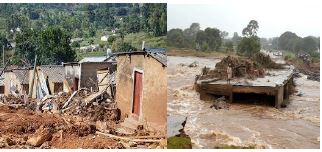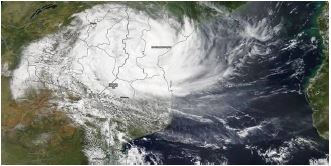Douglas Marowa, and
Angeline Musiya, from the different institute of the Zimbabwe. wrote a
research article about, Cyclone Idai Impact on Women's Livelihood in
Chimanimani, Zimbabwe. entitled, Climate shocks and women’s livelihood in
Zimbabwe: A case study on the impact of Cyclone Idai in Chimanimani District. This
research paper published by the Journal of Biodiversity and Environmental Sciences (JBES). an open access scholarly research journal on Biodiversity. under
the affiliation of the International Network For Natural Sciences |
NNSpub. an open access multidisciplinary research journal publisher.
Abstract
Climate shocks in
Zimbabwe have been of worry to the sustenance of women livelihoods. The study
sought to assess climate shocks and women’s livelihood in Chimanimani. To
recommend for future gender sensitive adaptation and mitigation measure.
Positivist and interpretivist paradigm, mixed research design were used. Used
sample of 1,464 women, questionnaires, interviews, direct observation and focus
groups for data collection. Findings, women were actively engaged in
agricultural and heavily affected by the cyclone. No special considerations for
women livelihoods. Adaptation strategies were early recovery, conservation
agriculture, water harvesting, climatic resilience crops and environmental
education. The provision of food aid as emergency phase, cash for work, and
food for work or assets. Noted mitigation were use of organic fertilisers to
reduce greenhouse gases, improved cropping, grazing and agro-forestry
practices. To increase biomass productivity and carbon sequestration, it was
also noted that there is now more reinforcement on forestry legislation to
reduced deforestation and promotion of afforestation/reforestation. Noted was
policy gaps in a gender based approach to climate shocks resilience and
preparedness, as there was a clear exhibition of ignorance on the fundamentals
of gender based approaches to climate chock resilience, mitigation and
preparedness in District. Recommend need to consolidate and mainstream policies
in harmonizing the sustainability of women livelihoods in climate shock resilience
undertakings and preparedness. Establishment of climate smart technology and
investing in breeding drought resilient crop varieties. Gender mainstream of
women livelihoods in climate shock resilience. Increased developmental
initiatives on capacity building and to strengthen environmental education
programmes.
Read more : Terra Preta Media and Corn Growth: Pyrolysis System Impact | InformativeBD
Introduction
According to the WMO
Conference (2006), the consequences of climate variability and climate change
have developed from being a fable to a truth as the disastrous results of its
harmful impacts are becoming more perceptible. The threat to human and food
security essentials are being felt in a big and overwhelming way for all to
observe. The disasters which have followed across the world are far reaching
and the resultant repercussions of global warming permeating indiscriminately.
The ever rising temperature and deterioration of the North and South Pole
glaciers, rising sea water levels and opposite effects in other parts of the
world, rainfall and droughts on mainland are the order of the day (Ncube et
al., 2016). The trail of disasters that are threatening the existence of
mankind on planet earth as the impacts are ravaging and as a result high
mortality, disaster induced displacements, outbreak of diseases and the
decimation of housing structures and the destruction of infrastructure is a
repeated challenge. Women vulnerability is therefore increasing in this global
matrix as they form the nucleus of the family heartbeat anchoring and
supporting family in all facets. It is women who are likely to be exposed to
the onslaught of climate change injuries creating food insecurities leading to
uncertainty to humanity.
The continuing traces of climate change provoked natural disasters that have badly affected Chimanimani District over the years due to cyclones that have been predicted and forewarned prior to happening continue to present women as punch bags to these circumstances thus germinating endemic cycles of poverty due to lose of livelihoods (AGRITEX, 2019). Cyclone Idai was a classic example of one which had been put on air two weeks before it hit the anticipated path. This has formed a cycle of likely disasters with no means in place to lessen the potential negative impacts with particular interest on the livelihoods of women in this district. As contrasting to developed countries, Zimbabwe’s government evident in the case of Chimanimani District was left wanting as no clear strategies were in place to safeguard the livelihoods of women despite proof of vulnerability and affirmation that such a disaster was looming. The lack of clearness and uncertainty of measures to undertake by the responsible authorities in order to minimize the threats to livelihoods had serious corollary. There is no clear appreciation and understanding of whether it is a challenge of capacity to implement precautionary measures or it is rather a policy gap with regards to adaptation and resilience strategies for sustainable livelihoods to women. AGRITEX (2019) reviewed that there has been a challenge of complying with the paradigm shift from disaster management to disaster risk management, which has become the global and regional yardstick for climate change imperatives with gender approaches being a prerequisite.
The disaster management complex has exposed communities to disaster risks rather than mitigation of the impacts prior to their manifestation the current floods bedevilling Chimanimani is empirical evidence that shows the sustaining challenge to the Chimanimani community.
Therefore, the impacts
on women’s livelihood are adverse and unlikely to be sustained under such
circumstances. An investigation then into the livelihoods of women becomes
pertinent. The main objective of this study was to assess and analysis the
climate shocks and women’s livelihood in Zimbabwe, a case study of Chimanimani
District. This was to recommend for future gender sensitive adaptation and
mitigation measure to the study area.
Reference
AGRITEX. 2019.
AGRITEX estimates shared at a TSURO post-Cyclone Idai research workshop, 3-4
July 2019, Harare.
Anand SV. 2013.
Global Environmental Issues 2, 632 doi:10.4172/ scientificreports.632
Bola G, Mabiza C,
Goldin J, Kujinga K, Nhapi I, Mushauri D. 2014. Coping with droughts and
floods: A case study of Kanyemba, Mbire District, Zimbabwe. Physics and
Chemistry of the Earth, Parts A/B/C 67, 180-186.
FAO. 2001g. Reducing
agricultural vulnerability to storm-related disasters. Document for the
Committee on Agriculture, COAG/01/6. Rome.
Gender and Climate
Change Network. 2007. Women for Climate Justice, Position Paper presented
at the UNFCCC COP13, Bali, Indonesia, December 2007.
Gukurume S. 2013. Climate
change, variability and sustainable agriculture in Zimbabwe’s rural
communities. Russian Journal of Agricultural and Socio-Economic Sciences 2(14), 89-100.
Huq N, Huge J, Boon E,
Gain AK. 2015. Climate change impacts in agricultural communities in rural
areas of coastal Bangladesh: A tale of many stories. Sustainability 7
IGES. 2004.
Institute for Global Environmental Strategies. (2004). Environmental Education
in Asia-Pacific.
IISD and Ministry of
Foreign Affairs of Denmark. 2007. Climate Change and Foreign Policy: An
Exploration of Options for Greater Integration
IPCC. 2007. The
Physical Science Basis- Summary for Policymakers: Contribution of Working Group
I to the Fourth Assessment Report Climate Change 2007 of the Intergovernmental
Panel in Climate Change.
IPCC. 2014. Climate
Change 2014: Synthesis Report. Contribution of Working Groups I, II and III to
the Fifth Assessment Report of the Intergovernmental Panel on Climate Change
[Core Writing Team: Pachauri.
Mapira J. 2014.
Zimbabwe’s Environmental Education Programme and its Implications for
Sustainable Development, A Dissertation Presented for the Degree of Doctor of
Philosophy (Curriculum Studies) at Stellenbosch University (RSA).
Muzari W, Muvhunzi S,
Soropa G, Kupika OL. 2014. Impacts of climate variability and change and
farmers’ responsiveness in the agricultural sector in Zimbabwe, International
Journal of Science and Research 3(9), 1726-1731.
Ncube M, Madubula N,
Ngwenya H, Zinyengere N, Zhou L, Francis J, Mthunzi T, Oliver O, Madzivhandila. 2016.
Climate Change household vulnerability and smart agriculture: The case of two
South African provinces. Jamba: Journal of Disaster Risk Studies
Nhemachena C. 2014.
Economic impacts of climate change on agriculture and implications for food
securirty in Zimbabwe. African Journal for Agriculture
Niang I, Ruppel OC,
Abdrabo MA, Essel A, Lennard C, Padgham J, Urquhart P. 2014. Africa. In
Climate Change (2014): Impacts, Adaptation, and Vulnerability. Part B: Regional
Aspects. Contribution of Working Group II to the Fifth Assessment Report of the
Intergovernmental Panel on Climate Change. Cambridge University Press,
Cambridge and New York.
Nkomwa EC, Joshua MK,
Ngongoond C, Monjerezi M, Chipungu F. 2014. Assessing IKS and climate change
adaptation strategies in agriculture: A case study of Chagaka Village,
Chikhwawa, Southern Malawi. Physical and Chemistry of the Earth, Parts
A/B/C 67, 1-252
Palmer JA. 1998.
Environmental Education in the 21st Century: Theory, Practice, Progress and
Promise, First Edition. London: Routledge.
Pereira JC. 2005.
Environmental issues and international relations, a new global (dis)order – the
role of International Relations in promoting a concerted international system.
Rev. Bras. Polític. Int. 58 (1), 191-209.
Risiro J. 2014. An
Evaluation on the Implementation of Environmental Education Program at Mutare
Teachers’ College in Zimbabwe. International Journal of Innovative Research and
Development 3(1), 264-271.
Sandford S. 1995.
Improving the efficiency of opportunism – new directions for pastoral
development. In I. Scoones, ed. Living with uncertainty – new directions in
pastoral development in Africa. London, Intermediate Technology Publications.
Sango I and Godwell
N. 2015b. Climate Change trends and environmental impacts in the Makonde
Communal Lands, Zimbabwe. Southern African Journal of Science 111(7-8)
Sinclair MR. 1994.
Objective identification of cyclones and their circulation, intensity and
climatic. Weather forecasting 12591-608.
Suckall N, Fraser E,
Forster P, Mkwambisi D. 2015. Using a migration systems approach to
understand the link between climate change and urbanization in Malawi. Applied
Geography 63, 244-252
Swai OW, Mbwambo JS and
Maganyane FT. 2012. Perceived effects of climate change on agricultural
production: A gendered analysis done in Bahi and Kondoa Districts, Dodoma
Region, Tanzania. Research on Humanities and Social Sciences
UNESCO. 2007.
Moving forward from Ahmedabad. Environmental education in the 21st century.
Fourth Intergovernmental Conference on Environmental Education, Ahmedabad
(India), 26-28 November. United Nations Educational, Scientific and Cultural
Organisation (UNESCO).
UNESCO-UNEP. 1996.
Environmental Education Newsletter Vol.1, No 1, UNESCO.
WMO. 2006. World
Meteorological Organization: Papers presented at the WMO Technical conference
on meteorological and environmental instruments and methods of observation
(TECO-2006). Geneva, Switzerland.
World Bank. 2013.
What Climate Change Means for Africa and Asia World Bank 22 June 2013.














%20in%20full.JPG)


0 comments:
Post a Comment